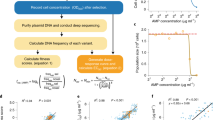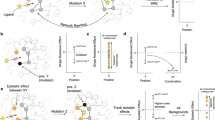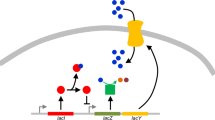Abstract
The distribution of fitness effects of protein mutations is still unknown1,2. Of particular interest is whether accumulating deleterious mutations interact, and how the resulting epistatic effects shape the protein’s fitness landscape. Here we apply a model system in which bacterial fitness correlates with the enzymatic activity of TEM-1 β-lactamase (antibiotic degradation). Subjecting TEM-1 to random mutational drift and purifying selection (to purge deleterious mutations) produced changes in its fitness landscape indicative of negative epistasis; that is, the combined deleterious effects of mutations were, on average, larger than expected from the multiplication of their individual effects. As observed in computational systems3,4,5, negative epistasis was tightly associated with higher tolerance to mutations (robustness). Thus, under a low selection pressure, a large fraction of mutations was initially tolerated (high robustness), but as mutations accumulated, their fitness toll increased, resulting in the observed negative epistasis. These findings, supported by FoldX stability computations of the mutational effects6, prompt a new model in which the mutational robustness (or neutrality) observed in proteins, and other biological systems, is due primarily to a stability margin, or threshold, that buffers the deleterious physico-chemical effects of mutations on fitness. Threshold robustness is inherently epistatic—once the stability threshold is exhausted, the deleterious effects of mutations become fully pronounced, thereby making proteins far less robust than generally assumed.
This is a preview of subscription content, access via your institution
Access options
Subscribe to this journal
Receive 51 print issues and online access
$199.00 per year
only $3.90 per issue
Buy this article
- Purchase on Springer Link
- Instant access to full article PDF
Prices may be subject to local taxes which are calculated during checkout



Similar content being viewed by others
References
Pal, C., Papp, B. & Lercher, M. J. An integrated view of protein evolution. Nature Rev. Genet. 7, 337–348 (2006)
DePristo, M. A., Weinreich, D. M. & Hartl, D. L. Missense meanderings in sequence space: a biophysical view of protein evolution. Nature Rev. Genet. 6, 678–687 (2005)
Wilke, C. O. & Adami, C. Interaction between directional epistasis and average mutational effects. Proc. R. Soc. Lond. B 268, 1469–1474 (2001)
Azevedo, R. B., Lohaus, R., Srinivasan, S., Dang, K. K. & Burch, C. L. Sexual reproduction selects for robustness and negative epistasis in artificial gene networks. Nature 440, 87–90 (2006)
Elena, S. F., Carrasco, P., Daros, J. A. & Sanjuan, R. Mechanisms of genetic robustness in RNA viruses. EMBO Rep. 7, 168–173 (2006)
Guerois, R., Nielsen, J. E. & Serrano, L. Predicting changes in the stability of proteins and protein complexes: a study of more than 1000 mutations. J. Mol. Biol. 320, 369–387 (2002)
Wolf, J. B., Brodie, E. D. & Wade, M. J. Epistasis and the evolutionary process (Oxford Univ. Press, Oxford, 2000)
Horovitz, A. Double-mutant cycles: a powerful tool for analyzing protein structure and function. Fold. Des. 1, R121–R126 (1996)
Charlesworth, B. Mutation–selection balance and the evolutionary advantage of sex and recombination. Genet. Res. 55, 199–221 (1990)
Bloom, J. D. et al. Thermodynamic prediction of protein neutrality. Proc. Natl Acad. Sci. USA 102, 606–611 (2005)
Wagner, G. P., Laubichler, M. D. & Bagheri-Chaichian, H. Genetic measurement of theory of epistatic effects. Genetica 102–103, 569–580 (1998)
Shafikhani, S., Siegel, R. A., Ferrari, E. & Schellenberger, V. Generation of large libraries of random mutants in Bacillus subtilis by PCR-based plasmid multimerization. Biotechniques 23, 304–310 (1997)
Daugherty, P. S., Chen, G., Iverson, B. L. & Georgiou, G. Quantitative analysis of the effect of the mutation frequency on the affinity maturation of single chain Fv antibodies. Proc. Natl Acad. Sci. USA 97, 2029–2034 (2000)
Guo, H. H., Choe, J. & Loeb, L. A. Protein tolerance to random amino acid change. Proc. Natl Acad. Sci. USA 101, 9205–9210 (2004)
Bowie, J. U., Reidhaar-Olson, J. F., Lim, W. A. & Sauer, R. T. Deciphering the message in protein sequences: tolerance to amino acid substitutions. Science 247, 1306–1310 (1990)
Sauer, U. H., San, D. P. & Matthews, B. W. Tolerance of T4 lysozyme to proline substitutions within the long interdomain α-helix illustrates the adaptability of proteins to potentially destabilizing lesions. J. Biol. Chem. 267, 2393–2399 (1992)
Huang, W., Petrosino, J., Hirsch, M., Shenkin, P. S. & Palzkill, T. Amino acid sequence determinants of β-lactamase structure and activity. J. Mol. Biol. 258, 688–703 (1996)
Wagner, A. Distributed robustness versus redundancy as causes of mutational robustness. BioEssays 27, 176–188 (2005)
Bloom, J. D., Labthavikul, S. T., Otey, C. R. & Arnold, F. A. Protein stability promotes evolvability. Proc. Natl Acad. Sci. USA 103, 5869–5874 (2006)
Kondrashov, A. S. Deleterious mutations and the evolution of sexual reproduction. Nature 336, 435–440 (1988)
Lynch, M., Burger, R., Butcher, D. & Gabriel, W. The mutational meltdown in asexual populations. J. Hered. 84, 339–344 (1993)
Kiel, C. & Serrano, L. The ubiquitin domain superfold: structure-based sequence alignments and characterization of binding epitopes. J. Mol. Biol. 355, 821–844 (2006)
Acknowledgements
We thank F. Kondrashov for insights and inspiration, L. Serrano, U. Alon and G. Schreiber for contributions, and our Department, Institute and the Feinberg Graduate School, for uncompromising support. Author Contributions S.B. designed, performed and analysed the experiments. M.S. and R.B. provided technical assistance. N.T. performed the FoldX computations and helped devise the model. D.S.T. designed and supervised the experiments, and devised the model. S.B. and D.S.T. wrote the manuscript.
Author information
Authors and Affiliations
Corresponding author
Ethics declarations
Competing interests
Reprints and permissions information is available at www.nature.com/reprints. The authors declare no competing financial interests.
Supplementary information
Supplementary Notes
This file contains the Supplementary Methods, Supplementary Figures 1–7 and Supplementary Tables 1–4. (PDF 465 kb)
Rights and permissions
About this article
Cite this article
Bershtein, S., Segal, M., Bekerman, R. et al. Robustness–epistasis link shapes the fitness landscape of a randomly drifting protein. Nature 444, 929–932 (2006). https://doi.org/10.1038/nature05385
Received:
Accepted:
Published:
Issue Date:
DOI: https://doi.org/10.1038/nature05385
This article is cited by
-
Positive epistasis drives clavulanic acid resistance in double mutant libraries of BlaC β-lactamase
Communications Biology (2024)
-
Designed active-site library reveals thousands of functional GFP variants
Nature Communications (2023)
-
In-cell kinetic stability is an essential trait in metallo-β-lactamase evolution
Nature Chemical Biology (2023)
-
Environmental selection and epistasis in an empirical phenotype–environment–fitness landscape
Nature Ecology & Evolution (2022)
-
Pervasive cooperative mutational effects on multiple catalytic enzyme traits emerge via long-range conformational dynamics
Nature Communications (2021)
Comments
By submitting a comment you agree to abide by our Terms and Community Guidelines. If you find something abusive or that does not comply with our terms or guidelines please flag it as inappropriate.



